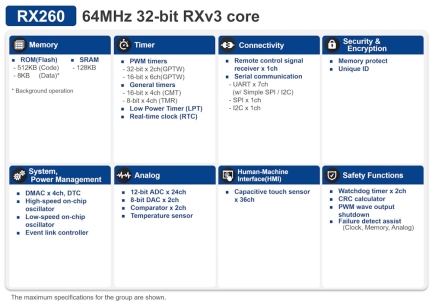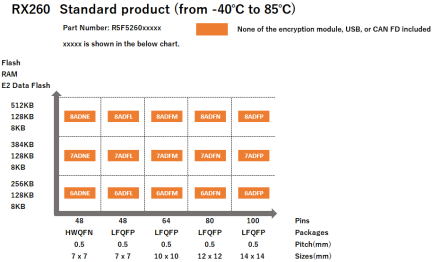Package Information
| Pitch (mm) | 0.5 |
| Lead Count (#) | 100 |
| Pkg. Type | LFQFP |
| Pkg. Dimensions (mm) | 14 x 14 x 1.7 |
| Pkg. Code | pkg_11659 |
Environmental & Export Classifications
| Moisture Sensitivity Level (MSL) | 3 |
| Pb (Lead) Free | Yes |
| ECCN (US) | |
| HTS (US) |
Product Attributes
| Carrier Type | Full Carton (Tray) |
| Family Name | RX |
| Series Name | RX200 |
| Group Name | RX260 |
| CPU Architecture | RX |
| Main CPU | RXv3 |
| Sub CPU | No |
| Floating Point Unit | Single |
| Bit Length | 32 |
| Program Memory (KB) | 256 |
| Data Flash (KB) | 8 |
| RAM (KB) | 128 |
| ECC SRAM | No |
| Lead Count (#) | 100 |
| Pkg. Type | LFQFP |
| Pitch (mm) | 0.5 |
| Pkg. Dimensions (mm) | 14 x 14 x 1.7 |
| Number of Supply Voltage(s) (#) | 1 |
| Supply Voltage (V) | 1.6 - 5.5 |
| I/O Ports | 92 |
| DMAC or DTC | DMAC&DTC |
| DMA (ch) | 4 |
| Temperature Sensor (ch) (#) | 1 |
| Power-On Reset | Yes |
| Watchdog Timer (ch) | 2 |
| External Memory Bus (bit) | No |
| DRAM I/F | No |
| 3D GPU | No |
| Accelerator | No |
| Temp. Range | Ta = -40 to +85°C |
| External Interrupt Pins (#) | 8 |
| LVD or PVD | Yes |
| Operating Freq (Max) (MHz) | 64 |
| Operating Freq of Sub CPU (Max) | 0 |
| Sub-clock (32.768 kHz) | Yes |
| On-chip Oscillator | Yes |
| Ethernet speed | No |
| Ethernet (ch) | 0 |
| EtherCat (ch) (#) | 0 |
| USB Ports (#) | 0 |
| USB FS (host ch/device ch) | ( 0 / 0 ) |
| USB HS (host ch/device ch) | ( 0 / 0 ) |
| USB SS (host ch/device ch) | ( 0 / 0 ) |
| PCI Express (generation and ch) | No |
| SCI or UART (ch) | 7 |
| SPI (ch) | 8 |
| QSPI (ch) | 0 |
| OSPI (ch) | 0 |
| I2C (#) | 8 |
| I3C (ch) | 0 |
| CAN (ch) | 0 |
| CAN-FD (ch) | 0 |
| Wireless | No |
| IrDA | No |
| LIN (#) | 0 |
| SDHI (ch) | 0 |
| High Resolution Output Timer | No |
| PWM Output (pin#) | 20 |
| 32-Bit Timer (ch) | 2 |
| 16-Bit Timer (ch) (#) | 10 |
| 8-Bit Timer (ch) | 4 |
| Standby operable timer | Yes |
| Asynchronous General Purpose Timer / Interval Timer (ch) | 0 |
| RTC | Yes |
| 16-Bit A/D Converter (ch) | 0 |
| 14-Bit A/D Converter (ch) | 0 |
| 12-Bit A/D Converter (ch) | 25 |
| 10-Bit A/D Converter (ch) | 0 |
| 24-Bit Sigma-Delta A/D Converter (ch) | 0 |
| 16-Bit D/A Converter (ch) | 0 |
| 12-Bit D/A Converter (ch) | 0 |
| 10-Bit D/A Converter (ch) (#) | 0 |
| 8-Bit D/A Converter (ch) | 2 |
| Analog Comparator (ch) | 2 |
| OPAMP (ch) (#) | 0 |
| PGA (ch) | 0 |
| Capacitive Touch Sensing Unit (ch) | 36 |
| Graphics LCD Controller | No |
| MIPI Interfaces (DSI) (ch) | 0 |
| MIPI Interfaces (CSI) (ch) | 0 |
| Camera I/F (Parallel) | No |
| Image Codec | No |
| 2D Drawing Engine | No |
| Segment LCD Controller | No |
| SSI (ch) | 0 |
| Security & Encryption | Unique ID |
| Debug Interface | Single-wire Serial |
| Moisture Sensitivity Level (MSL) | 3 |
| Country of Assembly | China |
| Country of Wafer Fabrication | Japan |
| ADC | 12-bit x 25-ch |
| Bit Size | 32 |
| CPU | RXv3 |
| DAC | 8-bit x 2-ch |
| DMA | Yes |
| Ethernet | No |
| Family Name | |
| Group Name | |
| Human Machine Interface | Capacitive Sensing Unit 36ch |
| Lead Compliant | Yes |
| Length (mm) | 14 |
| MIPI Interfaces (DSI/CSI) | 0 |
| MOQ | 720 |
| Pb (Lead) Free | Yes |
| SPI (#) | 8 |
| Tape & Reel | No |
| Thickness (mm) | 1.7 |
| Timer | 8-bit x 4-ch, 16-bit x 11-ch, 32-bit x 2-ch |
| UART (#) | 7 |
| Width (mm) | 14 |
Description
The RX260 group is a 32-bit microcontroller that delivers outstanding power efficiency and advanced touch functions. It is suitable for a wide range of applications including consumer electronics, industrial automation, building automation, and battery-powered products.
The RXv3 core delivers a high performance of 355CoreMark at 64MHz operation. Active current is 69μA/MHz, and standby current is 1μA. Power consumption can be minimized during intermittent operation by using a snooze mode that allows peripheral functions to operate during standby.
The third-generation capacitive touch sensing unit (CTSU2SL) is included as an HMI function. The CTSU2SL supports multi-frequency scanning to reduce false detection due to external noise, active shield to suppress the effects of water on the electrodes, the automatic judgment function to detect touch events without CPU activation, and the MEC function to reduce touch measurement time and current consumption for multiple electrodes.
In addition, the RX260 has the area protection function that allows the user to set a non-rewritable area on the code flash memory. This is ideal for storing secure boot programs, etc.


